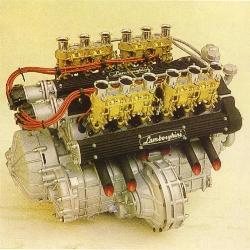 Factory publicity shot of a pre-production P400 engine. Click to enlarge.
Factory publicity shot of a pre-production P400 engine. Click to enlarge.
 Factory publicity shot of a pre-production P400 engine. Click to enlarge.
Factory publicity shot of a pre-production P400 engine. Click to enlarge.
Some references claim that the compression ratio increased for each engine. If the bore and stroke stayed the same, and the pistons and head combustion chamber did not change, then the compression ratio remained constant.
Another theory is that the valves were larger on the later engines. I've been told from reputable suppliers that there is no difference in the valves for the three engines. What about cams? Several people have said that the S and SV had more aggressive cam lobe profiles, and/or cam timing. Possible, but I find it hard to believe that cam profiles alone could account for the increases claimed in some of the literature. The carburettors were changed on the SV, but are the same on the P400 and S, and I doubt that would account for any significant increase in power in the SV.
While there were casting differences to seperate the sumps, I know of no engine changes that would affect horsepower. Perhaps with some differences in the cam profiles and timing, and/or induction ports in the heads there may be slight increases in power, but I doubt there were any significant design differences.
This has been the source of some friendly debates between myself and Joe Sackey. He has owned several SV's, and says that Bob Wallace showed him "at least 6 main physical differences between a P400 block and my SV block! ... The stroke, bore, pistons, combustion chamber, cams and carburettors were all changed and developed between 1966 and 1972. ... Often times the stroke, bore details were not passed on to the press which simply reported the new compression ratio!"
Since all engines use the same pistons, the bore did not change. Changing the stroke would mean the crankshafts are different. Clearly the debate will not end until some defninitive measurements are taken of the engines. I pledge to do further, quantative research to measure the differences in the engines. If anyone has reliable measurements, please share them!
1/12/02 - Visitor Guy Coldwell writes: "In my experience of Weber and from my Ferrari days and previous Urraco experience, the 3C stands for 'tre corpi' - three body or three barrel. I bet that the 3L designation stands for 'tre Lamborghini' and I would not be surprised if the carbs are identical or only have minor jetting changes. To amplify this, the Weber DCN carbs (3 bolt flange Dino 206) became 40 DCNF for Ferrari (4 bolt flange) on the 246 Dino and carburetted 308's while on the Urraco the same carb was a 40 DCNL for Lamborghini." Guy also wonders if the single distributor Miura engines were only fitted to cars with air conditioning to allow the compressor to sit in the position of the left distributor. I believe that once air conditioning was introduced as an option, all Miuras had one distributor. Any information to the contrary? Guy also suggested I look into TWM fuel injection as a bolt-on replacement for Webers. It might be good for driving the car, and I can save the Webers for shows.
1/11/04 - Udo Schuelke brought the PMO web site to my attention. They make replacement carburetor that are reported to be better than the original Webers, and some users claim better results than fuel injection. Udo also has a Miura, and we are both interested in hearing if any Miura owners have replaced their Webers with either of these options.